Although the Canon EOS 650D was the first DSLR to have a touchscreen, Canon sensibly decided that the touch controls should be in addition to rather than instead of the button and dial controls.
[Update: The EOS Rebel T5i (known as the EOS 700D outside the US) has since been replaced by the EOS Rebel T6i / EOS 750D and EOS Rebel T7i / EOS 800D. These newer models offer a number of improvements, notably higher-resolution 24MP sensors and better performance characteristics. However, that does mean the EOS Rebel T5i / EOS 700D should be able to be picked up at a very tempting price. Especially if you keep an eye on our Black Friday deals.]
This helped widen the camera's appeal, making it attractive to novices upgrading from a touchscreen smartphone or compact camera, as well as enthusiast photographers. As a result, according to Canon, the camera has sold very well.
Nevertheless after less than year the brand has decided to replace the Canon EOS 650D with the Canon EOS 700D, also known as the Canon EOS Rebel T5i. It sits alongside the Canon EOS 600D at the very top of Canon's "consumer" lineup, just below the Canon EOS 60D that starts its "enthusiast" range.
However, the new camera only makes a few upgrades on the model it replaces.
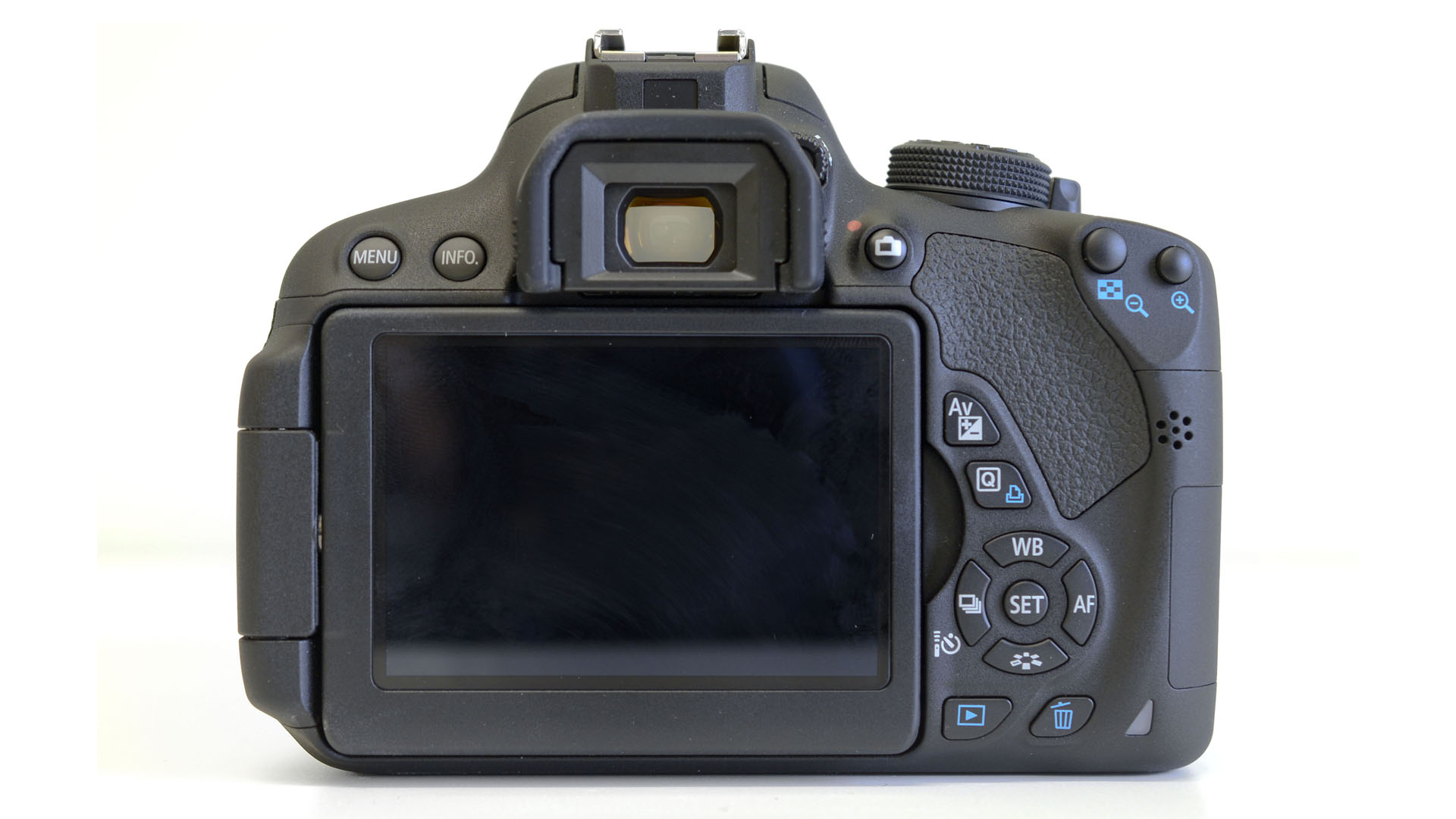
The vast majority of the Canon 700D’s specification is the same as the Canon 650D’s. For example, the 18 million pixel APS-C sized sensor and the 14-point Digic 5 processor are the same. It also has the same hybrid autofocus system for use in live view or video mode as well as a nine-point, all-cross type phase detection system for use when using the viewfinder.
As before, the sensor has pixels that are used for the phase detection part of the hybrid autofocusing system that is available when using Live View mode or shooting HD videos.

When the Hybrid AF is in action, it uses the central pixels to inform the phase detection part and get the subject close to sharp – from then, the contrast detection steps in to get it into full focus. This means that you can use the camera handheld. Canon claims that the performance of this system when one of the new STM lenses is mounted has been improved.
Like the Canon EOS 650D, the Canon EOS 700D can shoot at 5fps, and the sensitivity can be set in the native range ISO 100-12800, which can be expanded to ISO 25,600 if necessary. This makes it a pretty versatile camera, capable of shooting in a wide range of situations.
One of the biggest changes brought with the new camera is that the impact of the Creative Filters (Grainy Black and White, Soft Focus, Fish-Eye, Art Bold, Water Painting, Toy Camera and Miniature Effect) can be previewed on the screen when shooting in Live View mode – just as you can with the Canon EOS 100D and the Canon EOS M.
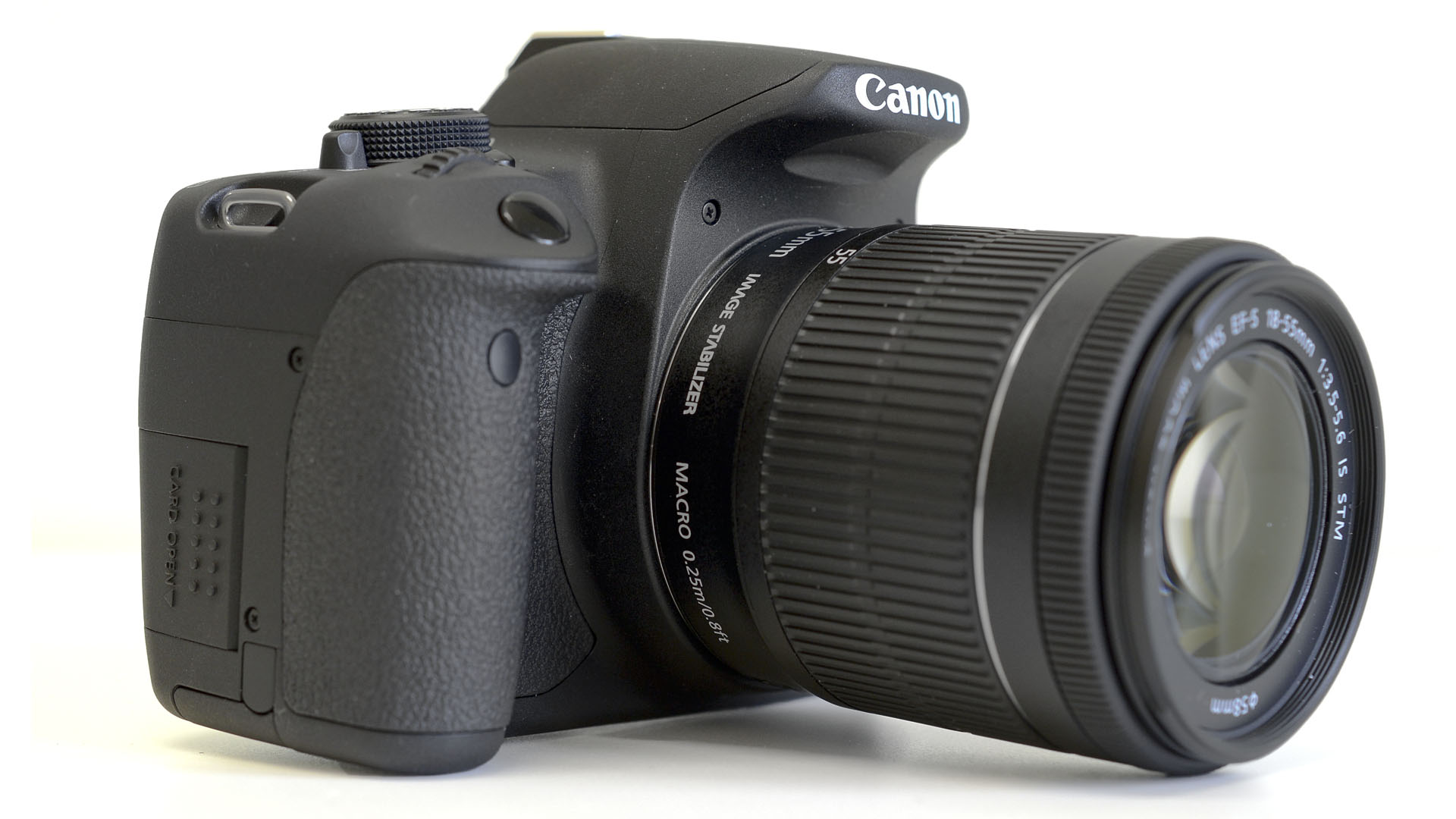
However, these are still a JPEG-only option, so you can’t have a ‘clean’ raw file recorded with the JPEG. If you want an unfiltered image as well as one with the effect on, you need to apply the filter post-capture using the Canon EOS 700D’s post-processing options.
Alternatively, the Canon EOS 700D has the usual array of Picture Styles (Standard, Portrait, Landscape, Neutral, Faithful and Monochrome) as well as Auto, in which the camera selects what it calculates to be the appropriate option automatically, plus it can apply three user-defined styles.
All of the preset options can be adjusted to taste and can be used when shooting raw as well as JPEG files.

The Canon EOS 700D has also been designed to have a more expensive feel, with a textured coating and a 360-degree mode dial added. The latter means it can be twisted all the way around, rather than reaching a point where it stops and has to be twisted back again.
The Canon EOS 700D/Canon EOS Rebel T5i has a full asking price of £619.99 / AU$ 849 / US$ 749 body only or £749.99 / AU$ 999 / US$ 899.99 with the new 18-55 STM lens.
This means that it goes head to head with the 24 million pixel Nikon D5200, which was announced at the end of 2012.
Canon has clearly used the same mould for the EOS 700D as it did for the EOS 650D, since the two camera bodies look almost identical, with the only visible difference being a change to the mode dial.
The icons on the Canon EOS 700D’s dial are raised rather than just painted and it’s edged with a finer texture. This higher-quality dial can also be rotated through 360 degrees, so you don’t have to turn it backwards and forwards to reach the options you want.
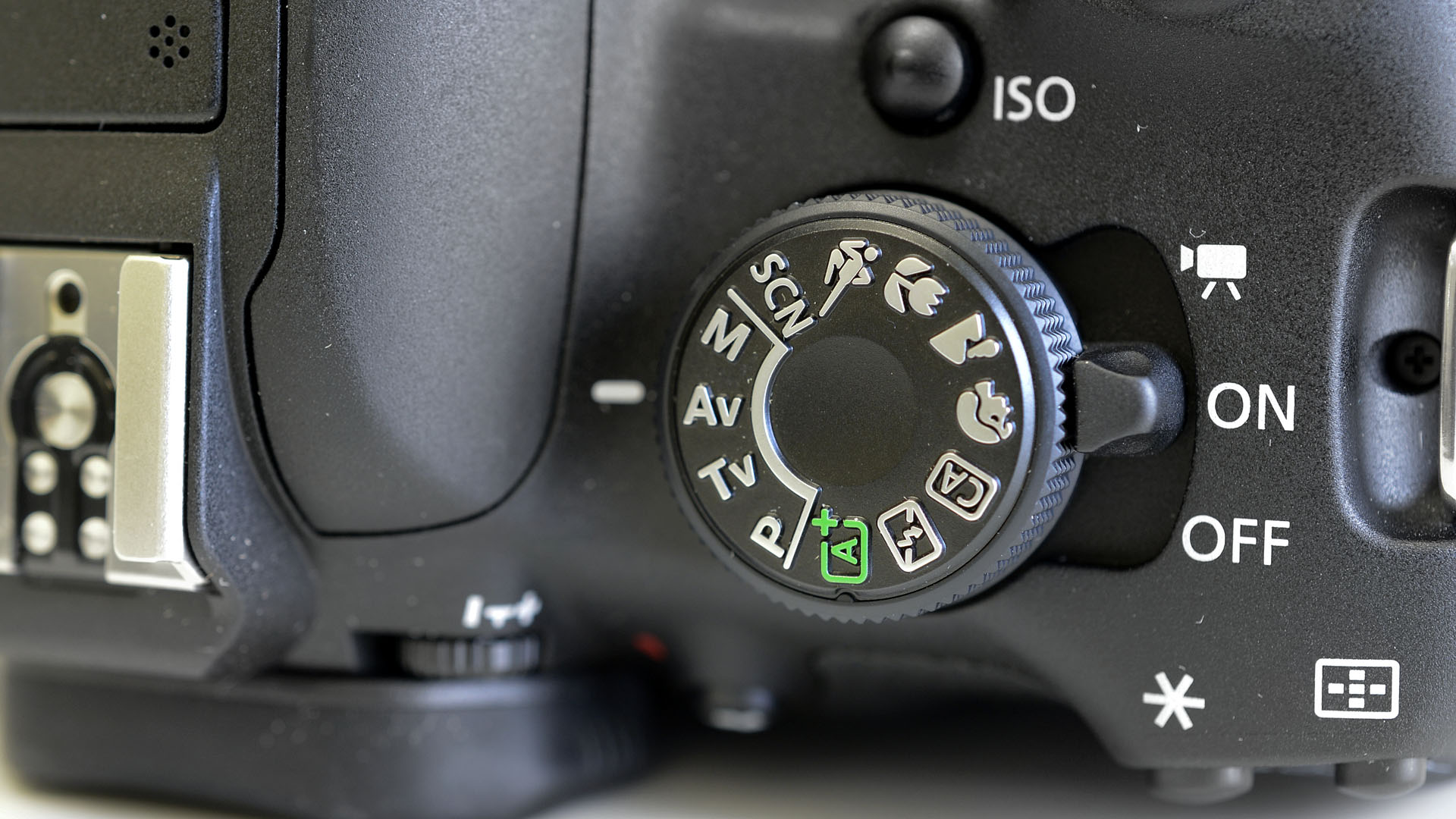
Rubbing a finger over the two cameras also reveals that they have a slightly different texture, with the Canon EOS 700D feeling a little coarser – in a good way. The rubberised coatings over the finger and thumb-grips remain the same and give good purchase.
While it lacks the robustness of Canon’s professional-level DSLRs, the Canon EOS 700D feels well made, with no movement detectable at any of the joints. The articulating joint that attaches the LCD screen and enables it to be rotated around for viewing from very high or low angles, or from in front of the camera, has a high quality feel.
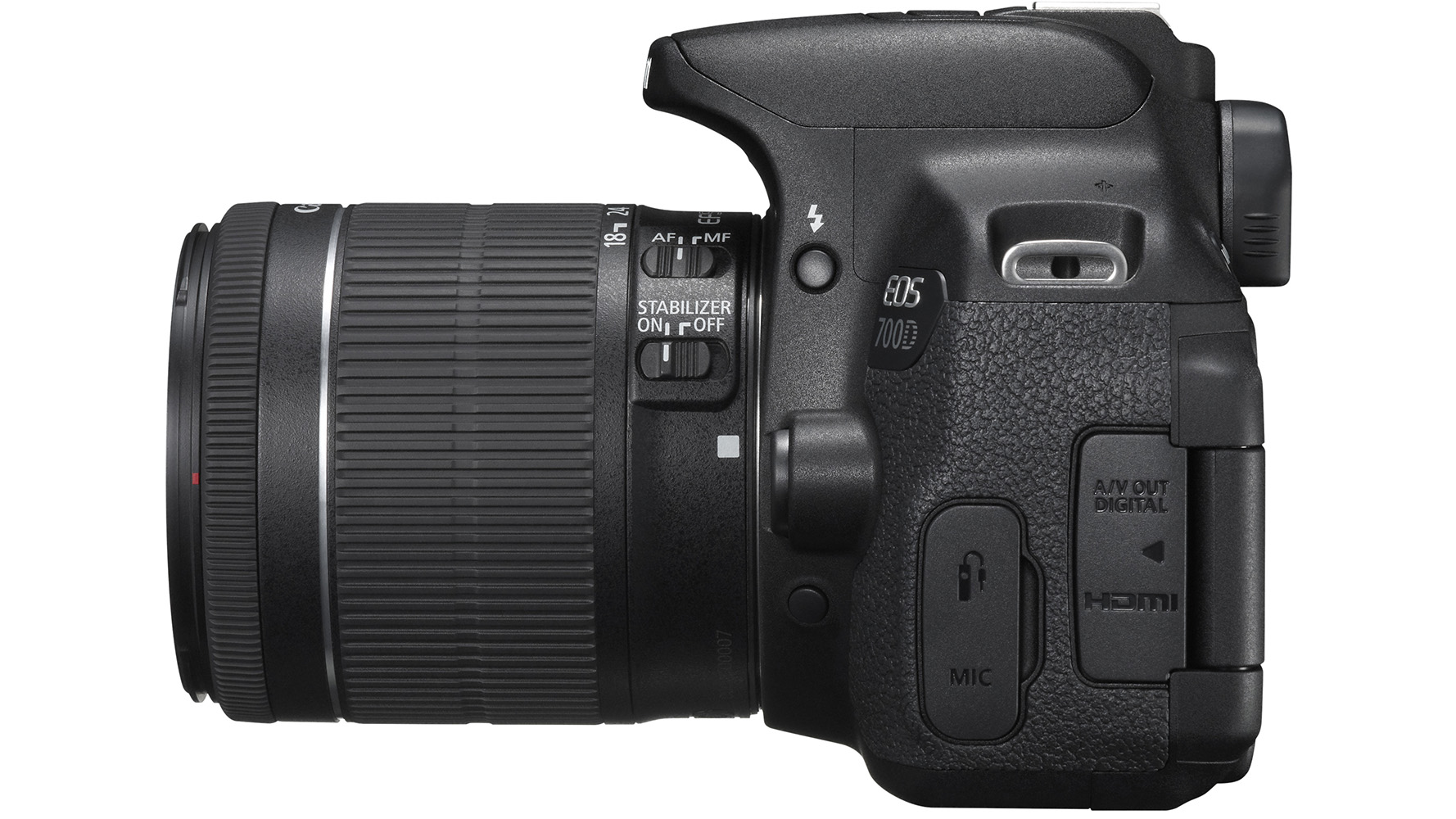
The Canon EOS 700D has the same control and menu layout as the Canon EOS 650D that it replaces. As before the menu is spread across 11 tabbed screens in stills mode, including a My menu option to which you can assign up to six features for quick access – we find it helpful to use this to reach the Mirror lock-up, Highlight tone priority, Auto Lighting Optimizer and Flash control options.
The menu can be navigated and options selected via the touchscreen or the button and dial controls.
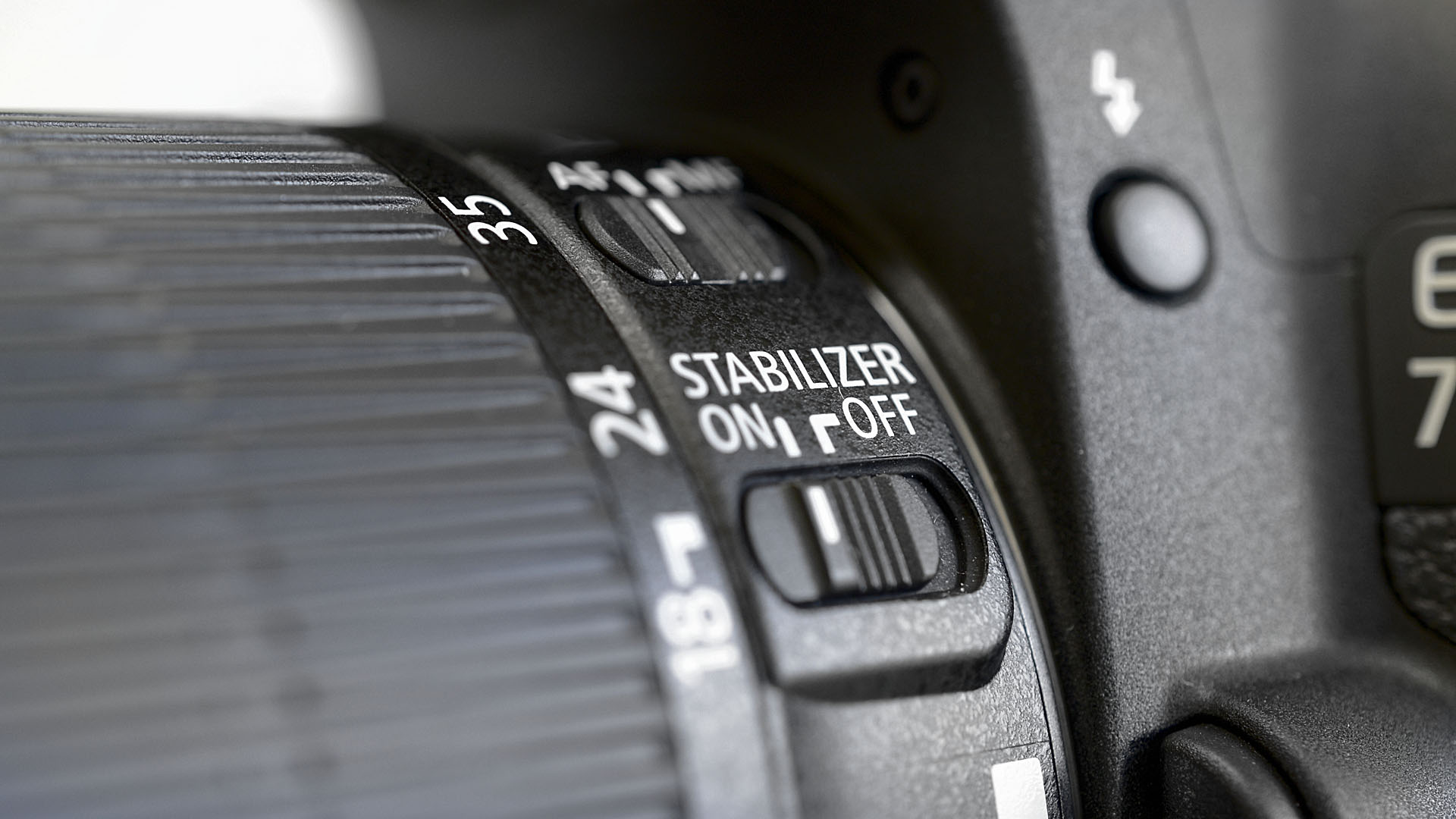
There’s also a Quick menu that you can activate either by pressing the physical Q button or by touching the Q icon on the LCD screen. This gives a quick route to the mostly commonly needed camera settings.
If the Feature Guide is activated via Set-up Menu 3, touching an on-screen icon once brings up an explanation of the feature, while a second touch displays its available options. A single touch is all that is required if the Feature Guide is deactivated.
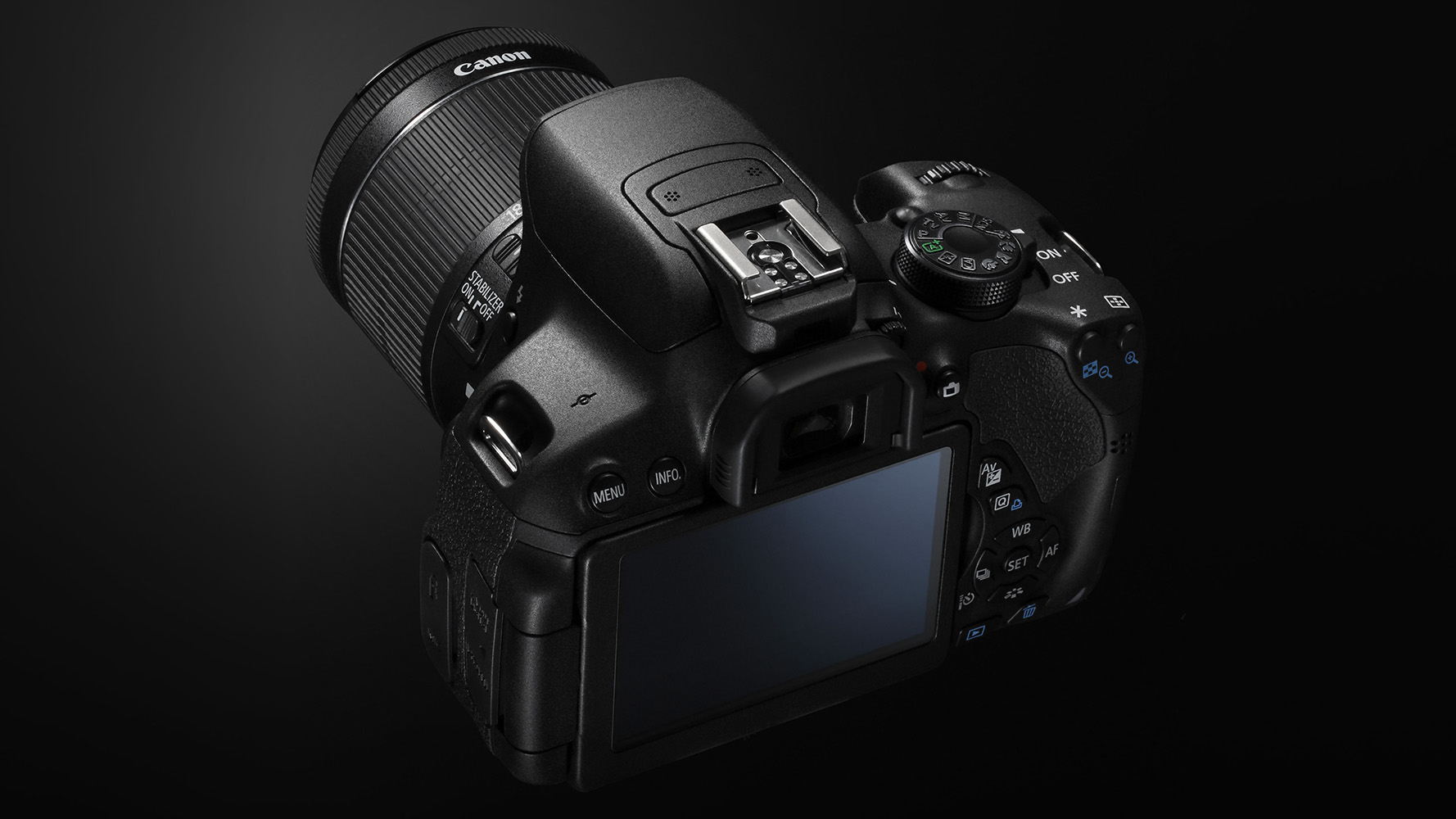
As on the Canon EOS 650D, the power switch has a third option that’s used to activate Movie mode. Once this has been done, the button on the back of the camera that starts Live View in stills mode becomes the movie record button.
Although the Canon EOS 700D has all the button and dial controls that we expect from a camera at this level, it is also possible to control the camera via the 3-inch 1,040,000-dot touchscreen. This is very responsive, and once you start using the touch controls you find that you use them more and more because they are so intuitive.
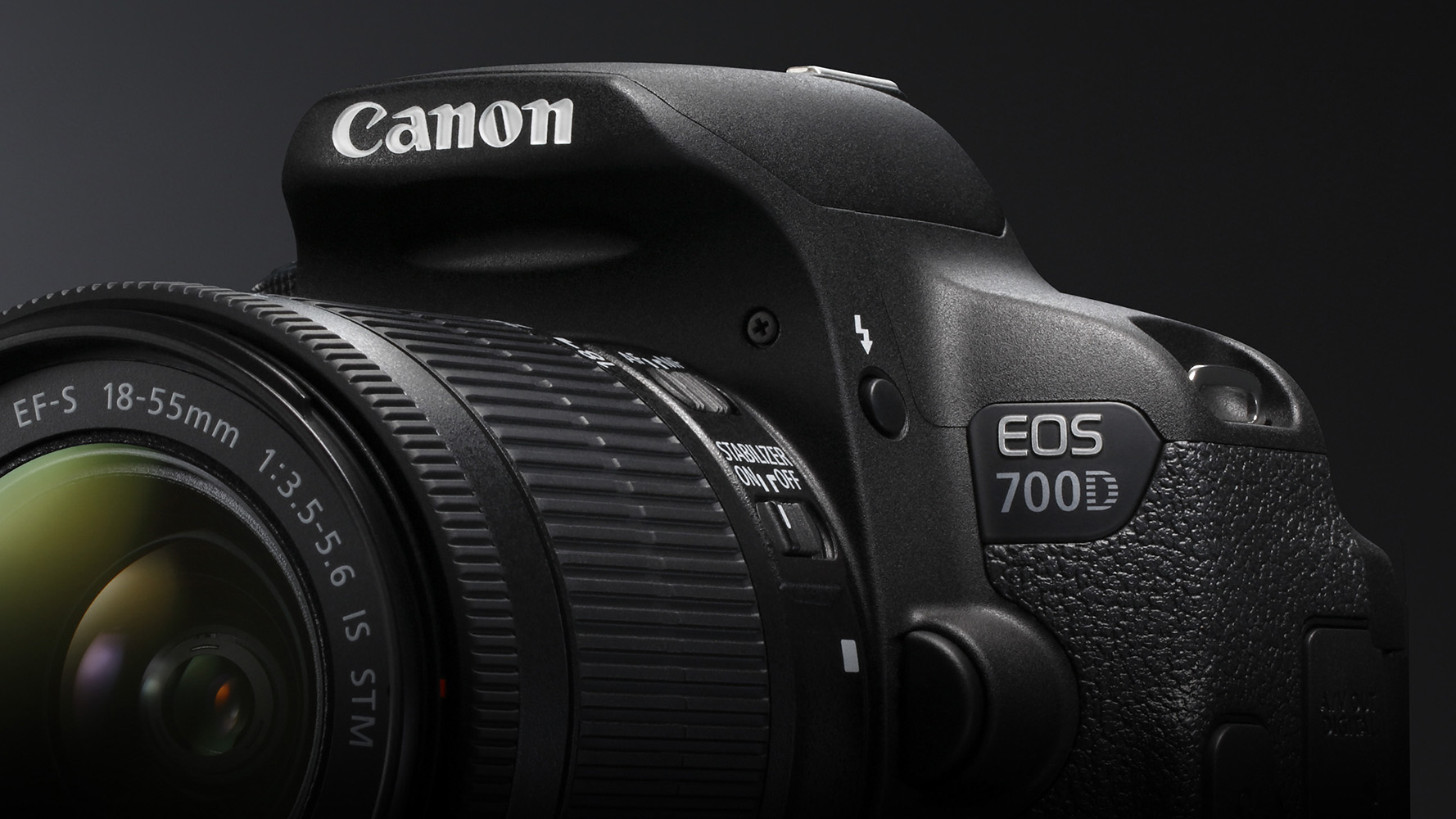
It’s great to be able to swipe across the camera’s screen to scroll through images and then pinch to zoom in to inspect details. It’s just a shame that Canon has buried the rating control in the menu.
We found that the vari-angle screen provides a good, clear view with lots of detail visible even in quite bright light, making it very useful when composing images at ground level or above head-height.
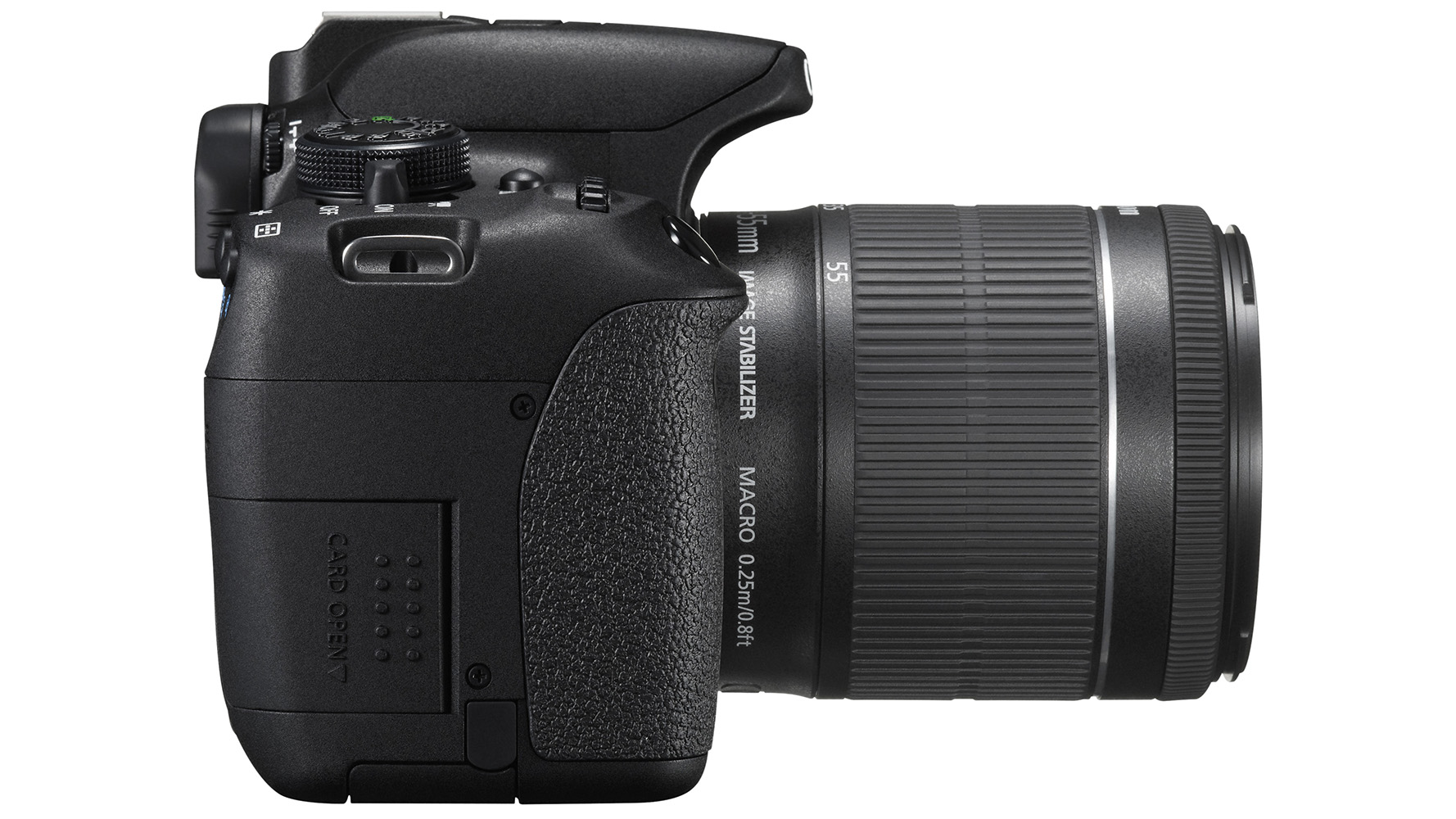
The touch-shutter facility, which enables the AF to be set and the shutter tripped with a touch of a finger on the screen, is particularly helpful in these situations.
However, the screen inevitably gets covered in fingerprints and these obscure the view, so it’s a good idea to carry a decent lens cloth with you so you can give it a wipe now and then.

Because it’s a DSLR rather than a compact system camera, the Canon EOS 700D has an optical viewfinder. While this only covers 95% of the frame and carries the risk of including a few extra elements along the edges of images, it is bright and pleasant to use.
As usual these days, when given the choice we would opt to compose images in the LCD when focusing manually, because the enlarged view makes it easier to be precise with the focus point.
Given that they have the same sensor, it’s not surprising to discover that the Canon EOS 700D can resolve the same amount of detail as the Canon EOS 650D, and that the two cameras’ image quality is very similar.
Noise is well controlled throughout the sensitivity range, although as you’d expect, images taken using the upper ISO values have some coloured speckling visible. It’s interesting that our lab tests reveal that the Canon 700D produces slightly noisier images than the Canon 650D at the lower to mid sensitivity settings. Canon has probably made this change to the image processing to bring out a bit more detail.
The Canon 700D can produce high-quality images direct from the camera with plenty of detail and pleasant, natural colours, but as usual the best results are produced from raw files that are carefully processed.
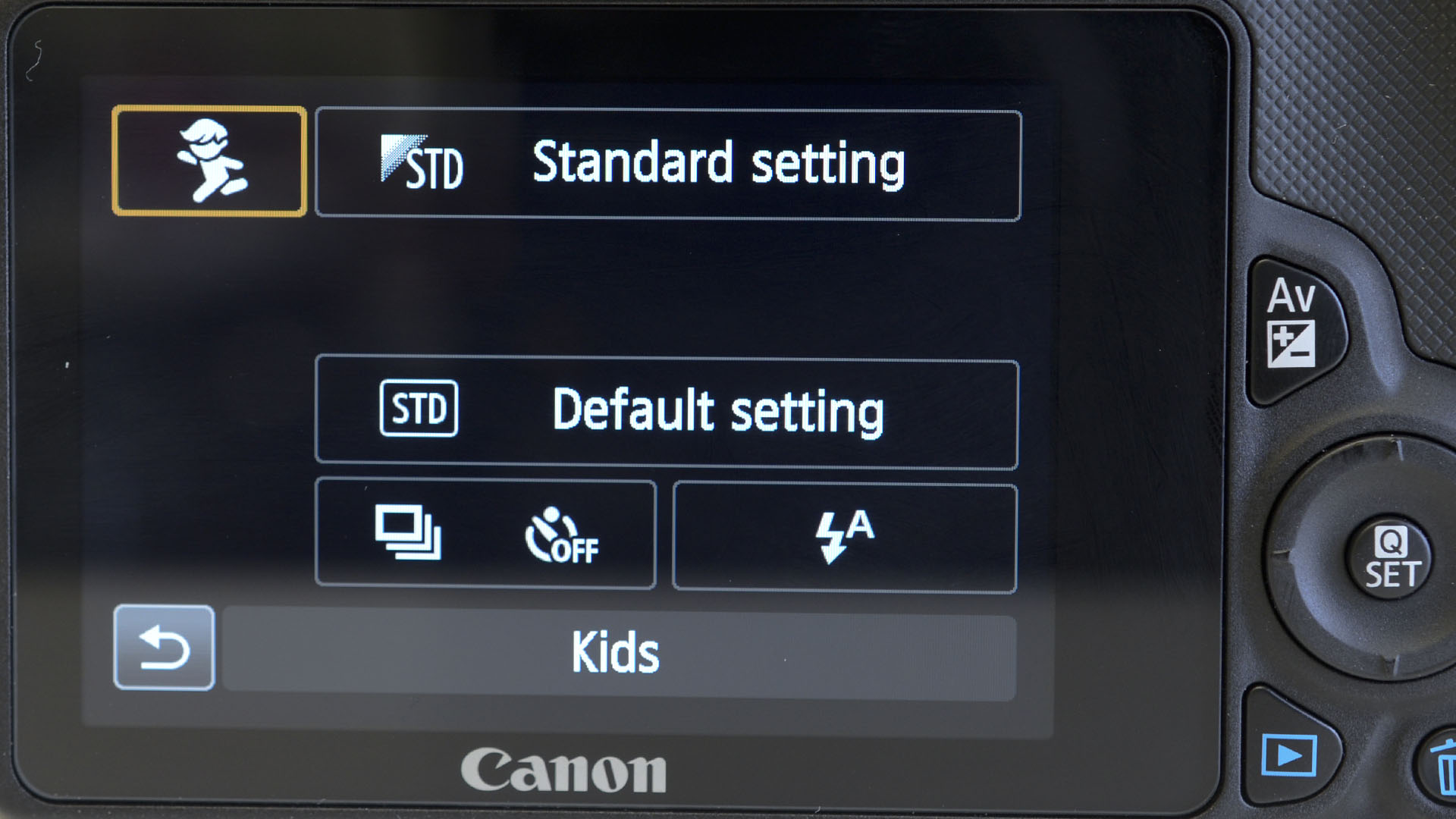
Examining our images at 100% on the screen indicates that the camera’s default sharpening is a little on the high side, and more natural images are created by turning the in-camera Sharpness value down.
As is Canon’s way, the white balance tends to lean a little towards warm tones, but this isn’t dramatic and it usually results in more attractive images.
However, Canon’s evaluative metering system continues to give mixed performance. In some situations it is superb, but in high contrast conditions you need to be alert to the brightness of the subject under the active AF point, since this can skew the result.
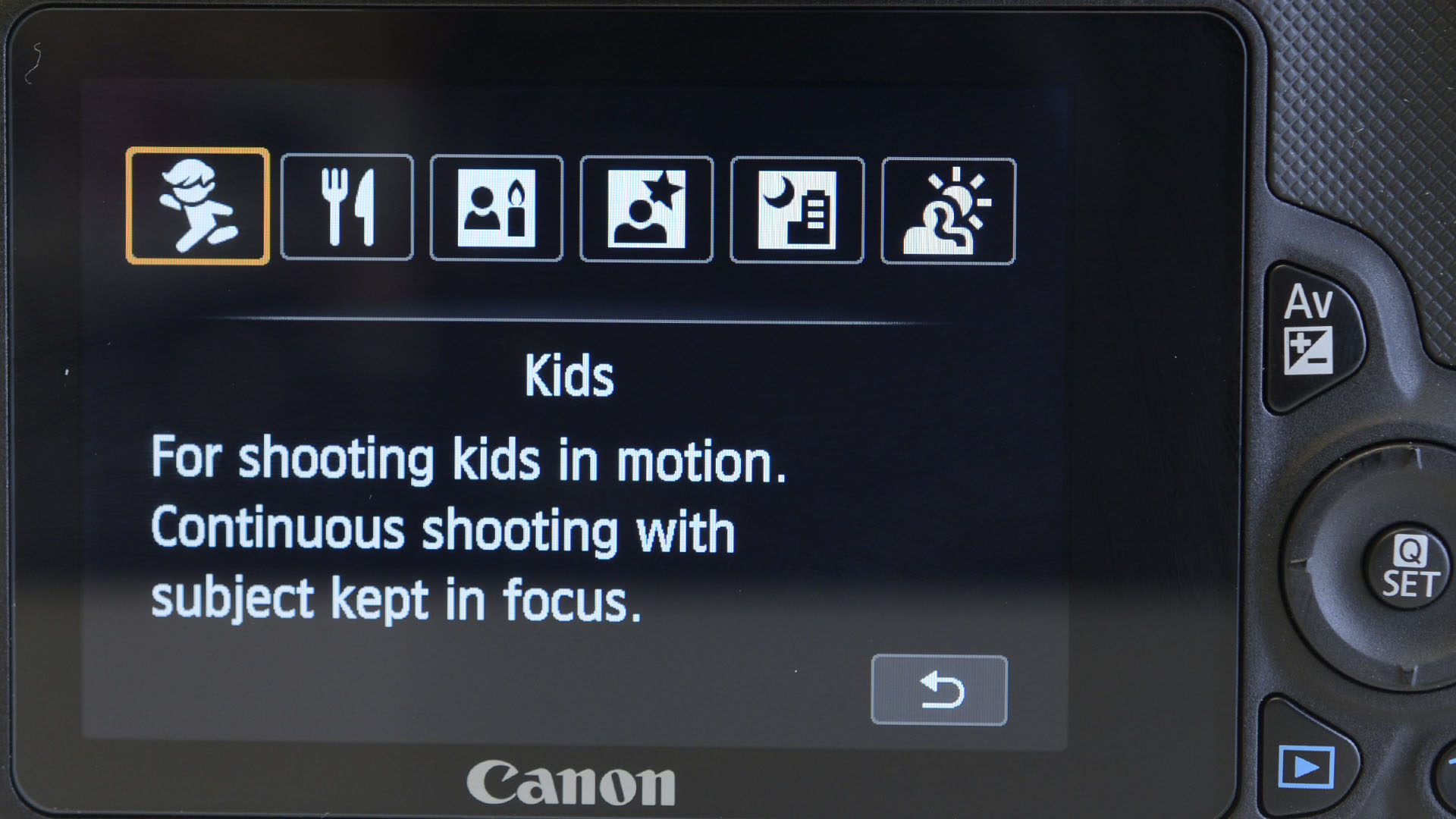
Bright subjects can trick the camera into under exposure, while dark ones can lead to over exposed images. This is an issue throughout the Canon DSLR range, but it seems especially strange in models that the company is aiming at novice photographers (as well as enthusiasts), such as the Canon EOS 100D and Canon EOS 700D.
While most users want the subject to be correctly exposed, few will be happy with a wildly over exposed landscape because the focus point is in shadow.
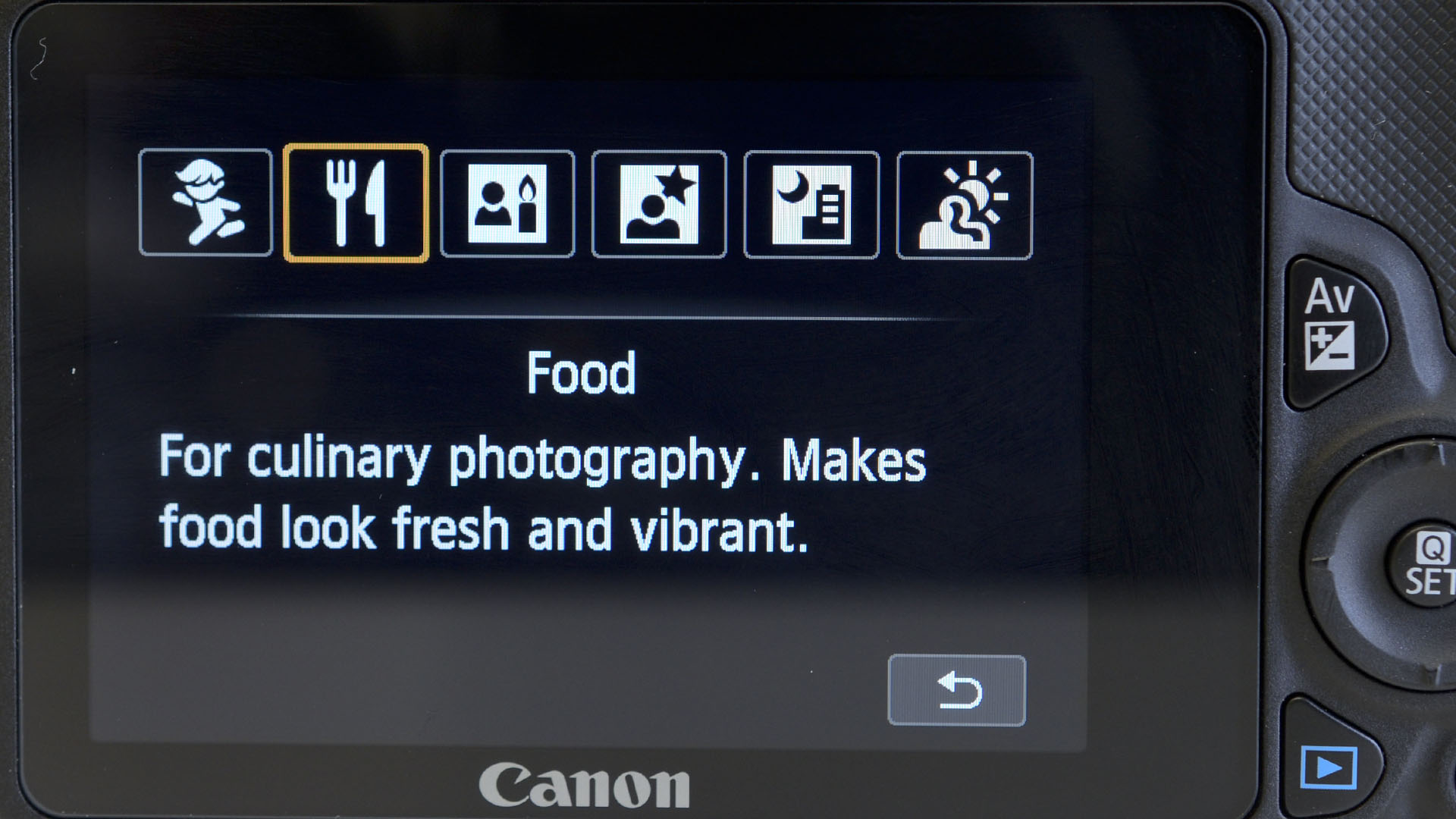
With a dynamic range of almost 12EV at ISO 200 and ISO 400, it’s clear that the Canon 700D is capable of recording a wide range of tones. However, these are compressed in the JPEG files to create a higher contrast image with more punch. Unlike the results for signal to noise ratio, our dynamic range measurements for the Canon 700D match those from the Canon 650D almost exactly.
Our tests confirm that Canon has improved the performance of the hybrid focusing system that’s available in Live View and video mode.
We found that the Canon EOS 700D is appreciably quicker to achieve focus with one of the STM lenses mounted than the Canon EOS 650D. Nevertheless, the focusing still isn’t really fast enough to be used with a moving subject.

When you use the viewfinder to compose images, the Canon 700D reverts to the more standard phase detection autofocus system. This works well, with each cross-type point finding its target quickly and accurately even in quite low light and with low contrast subjects.
The only down side is that with ‘just’ nine AF points it’s often necessary to focus the lens and then recompose the image, because there isn’t a point directly over the subject.
Canon’s STM lenses really come into their own when shooting video, and the new 18-55mm f/3.5-5.6 IS STM kit lens’s focusing is very quiet and smooth when Movie Servo AF is enabled.
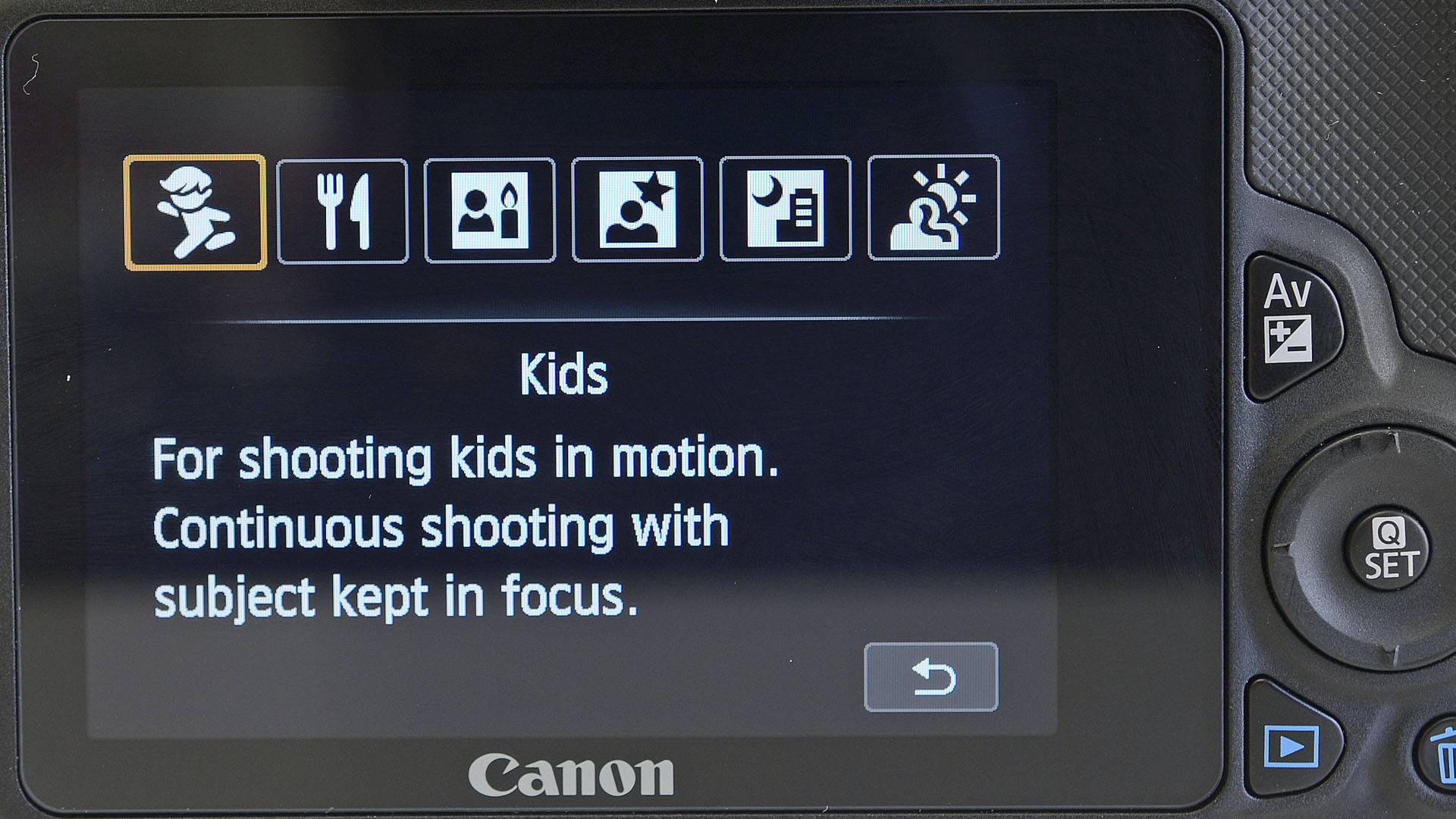
It’s so smooth, in fact, that sometimes it’s hard to tell that the focus is slowly being adjusted. The end result, however, is very high quality footage with no sound of the focusing system in action.
While post-processed raw files generally create better monochrome images, it’s very helpful to have an idea of how the final images will look. It’s also fun trying to get shots just right in-camera. The Canon 700D’s Monochrome Picture Style produces some excellent results, with subtle toning being possible. In many cases the images are print-ready.
As part of our image quality testing for the Canon EOS 700D, we’ve shot our resolution chart.
If you view our crops of the resolution chart’s central section at 100% (or Actual Pixels) you will see that, for example, at ISO 100 the Canon EOS 700D is capable of resolving up to around 22 (line widths per picture height x100) in its highest quality JPEG files.
For a full explanation of what our resolution charts mean, and how to read them, check out our full explanation of our camera testing resolution charts.
Examining images of the chart taken at each sensitivity setting reveals the following resolution scores in line widths per picture height x100:
JPEG

Full ISO 100 image, see the cropped (100%) versions below.
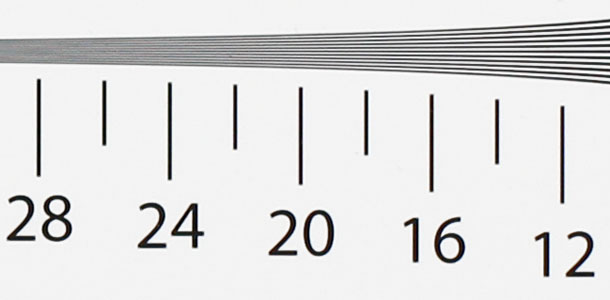
ISO 100, score: 22 (Click here to see the full resolution image)
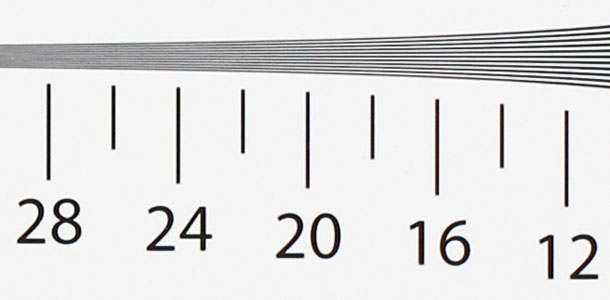
ISO 200, score: 22 (Click here to see the full resolution image)
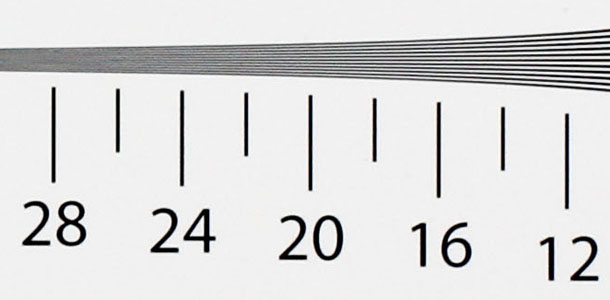
ISO 400, score: 22 (Click here to see the full resolution image)
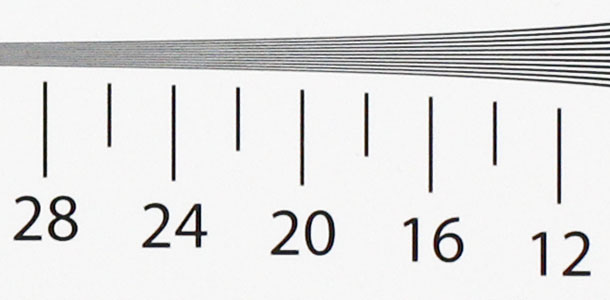
ISO 800, score: 22 (Click here to see the full resolution image)
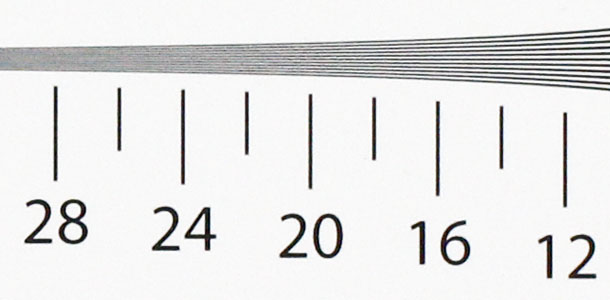
ISO 1600, score: 20 (Click here to see the full resolution image)
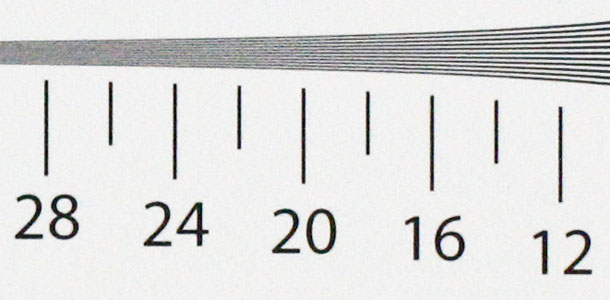
ISO 3200, score: 18 (Click here to see the full resolution image)

ISO 6400, score: 18 (Click here to see the full resolution image)
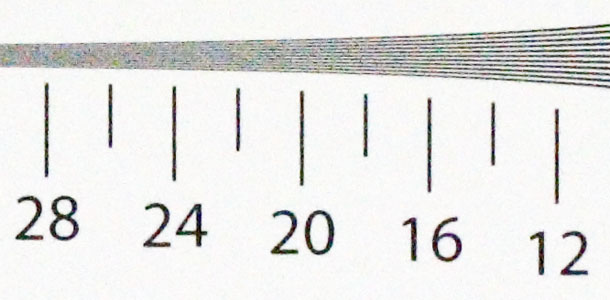
ISO 12800, score: 16 (Click here to see the full resolution image)
Raw
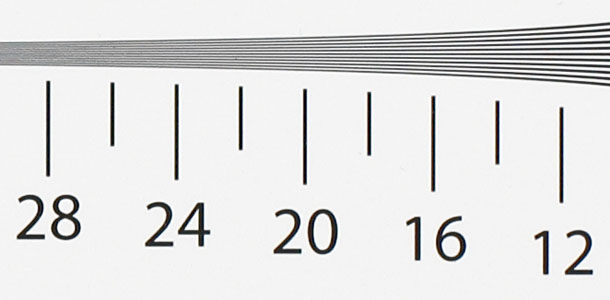
ISO 100, score: 24 (Click here to see the full resolution image)
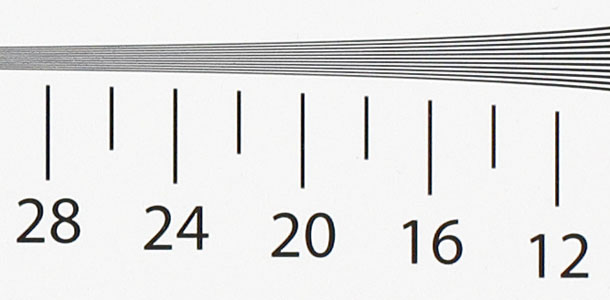
ISO 200, score: 24 (Click here to see the full resolution image)

ISO 400, score: 22 (Click here to see the full resolution image)

ISO 800, score: 22 (Click here to see the full resolution image)
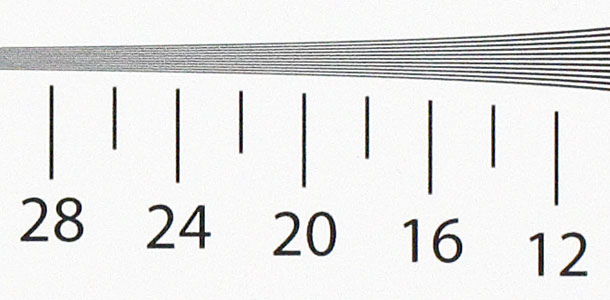
ISO 1600, score: 20 (Click here to see the full resolution image)

ISO 3200, score: 20 (Click here to see the full resolution image)
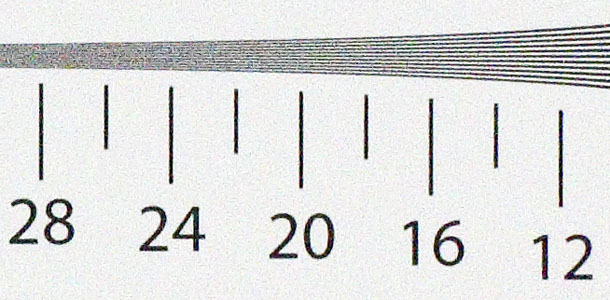
ISO 6400, score: 18 (Click here to see the full resolution image)

ISO 12800, score: 18 (Click here to see the full resolution image)
We shoot a specially designed chart in carefully controlled conditions and the resulting images are analysed using DXO Analyzer software to generate the data to produce the graphs below.
A high signal to noise ratio (SNR) indicates a cleaner and better quality image.
For more more details on how to interpret our test data, check out our full explanation of our noise and dynamic range tests.
Here we compare the Canon EOS 700D with the Nikon D3200, Canon EOS 650D, Nikon D5200 and Sony Alpha 58.
JPEG signal to noise ratio
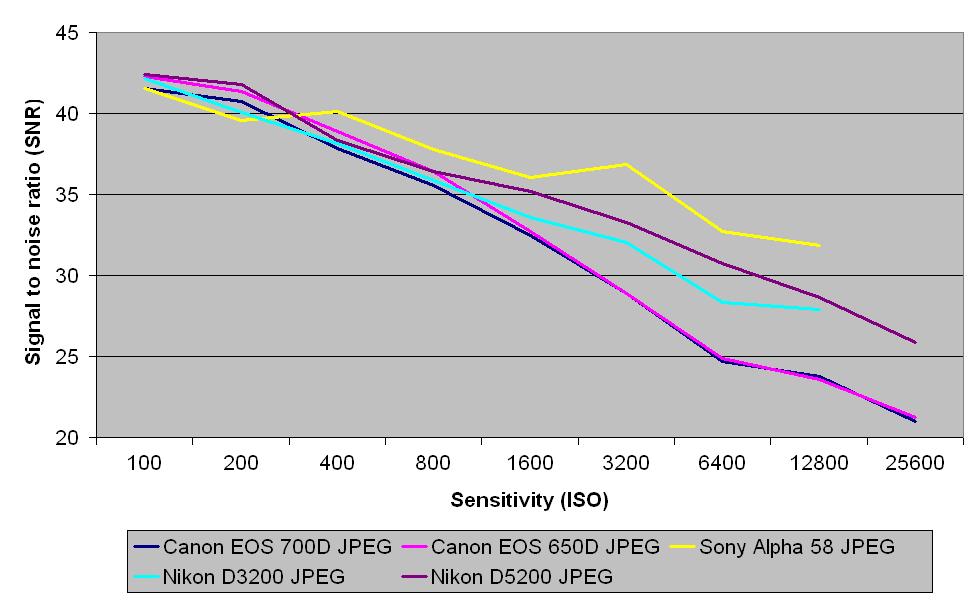
At the lower sensitivity settings the Canon 700D has a slightly lower signal to noise ratio (SNR) than the 650D it replaces indicating that it produces JPEGs with a little more noise. This is probably to reveal a little more detail. Beyond ISO 1600 the 700D’s SNR is a very close match for the 650D’s and both are beaten by the Nikon D3200, Nikon D5200 and Sony Alpha 58.
Raw signal to noise ratio
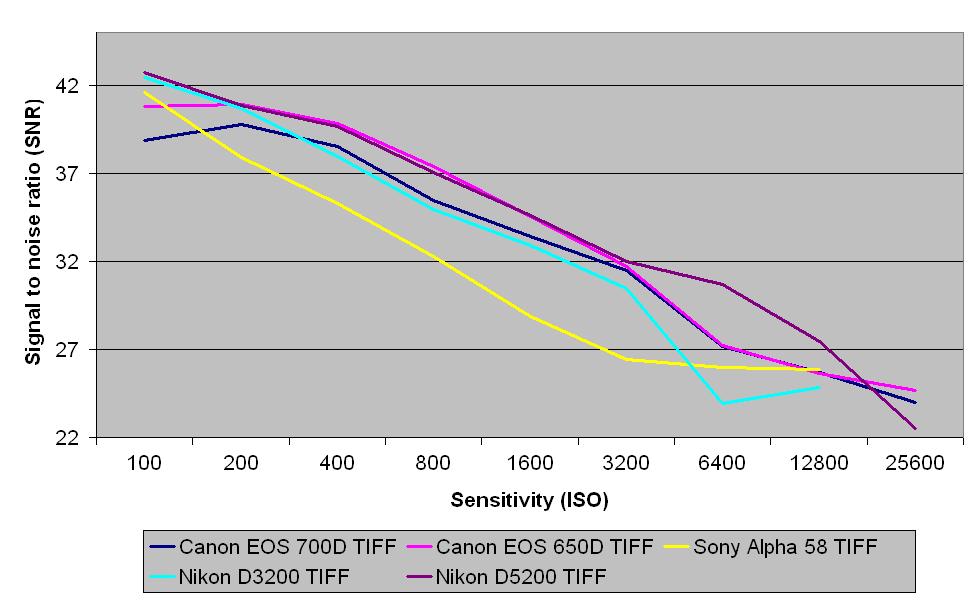
As with the JPEG files, after conversion to TIFF the raw files from the Canon 700D have a lower SNR than the Canon 650D‘s files up to around ISO 3200. With the exception of the lower sensitivity settings, the 700D beats the Sony Alpha 58, but it a fairly close match for the Nikon D3200 and Nikon D5200.
JPEG dynamic range

While it doesn’t match the Sony Alpha 58, Nikon D5200 or Nikon D3200 for JPEG dynamic range it seems likely that Canon has done this deliberately to produce higher contrast images that look print-ready.
Raw dynamic range

The 700D’s raw file (after conversion to TIFF) dynamic range is a very close match for the Canon 650D‘s – hardly surprising given that they have the same sensor and processing engine. The highest dynamic range is achieved at ISO 200 and ISO 400 (from where it more-or-less matches those of the Nikon D3200 and Sony Alpha 58). The Nikon D5200‘s raw files (after conversion to TIFF) have the widest dynamic range at any sensitivity setting indicating that it can capture the widest range of tones ina single shot.
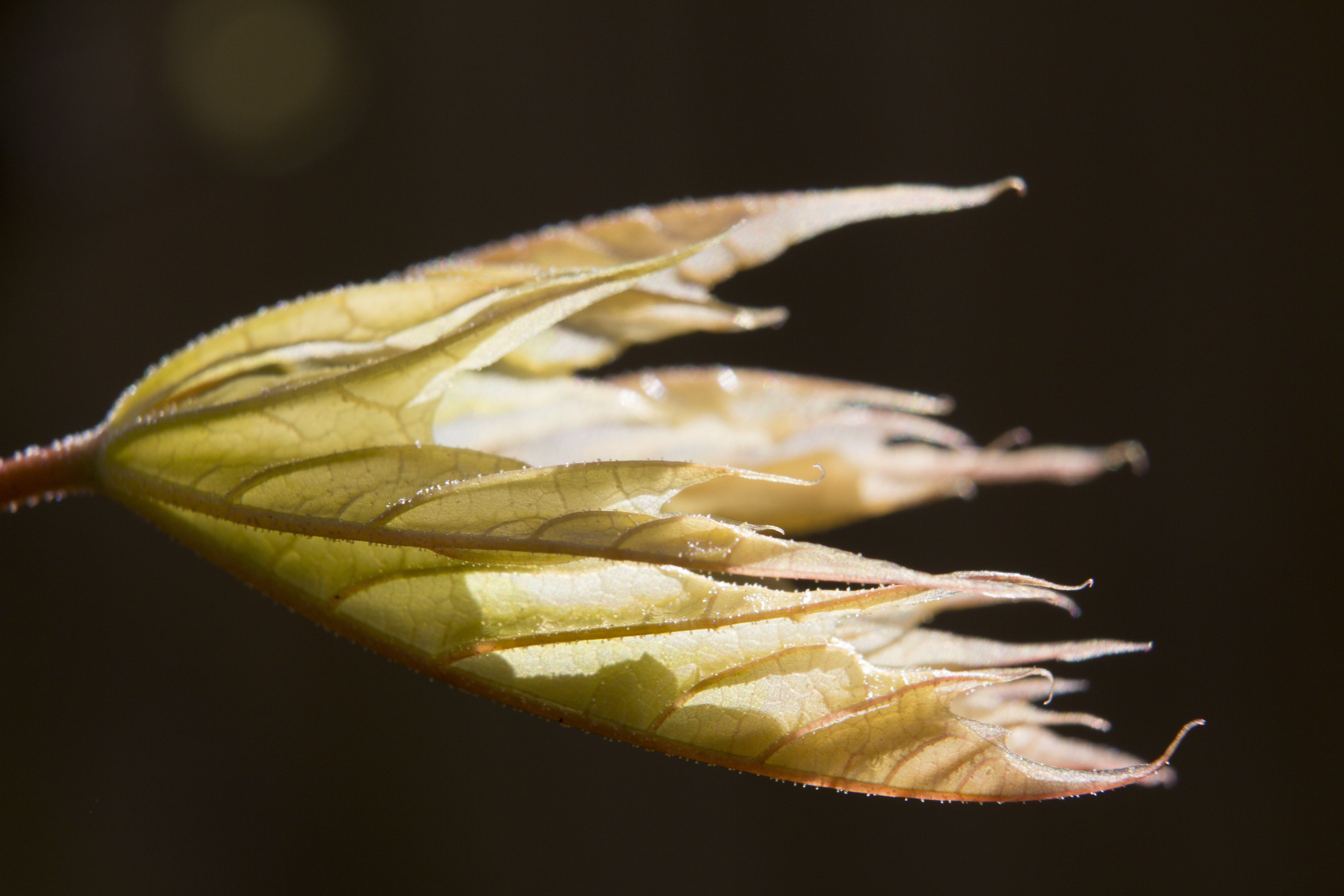
Click here to see the full resolution image
Using an extension tube has restricted depth of field, but there’s lots of detail in the sharp areas of this shot, taken in early morning light. An extra 1/3EV exposure was dialled in to get this accurate result.

Click here to see the full resolution image
The vari-angle screen makes it easy to compose images from awkward angles like this. It’s also helpful to be able to set the AF point, and even trip the shutter, with a touch of the finger on the screen.

Click here to see the full resolution image
This toned shot was created in-camera at the capture stage using the Monochrome Picture Style. Helpfully, it’s possible to shoot raw images at the same time so there’s a clean file to work on as well if you want.

Click here to see the full resolution image
We had to increase the exposure by 2/3EV over that suggested by the evaluative metering to get this image. It could still benefit from a little post-capture brightening, but the skin tones are spot-on.
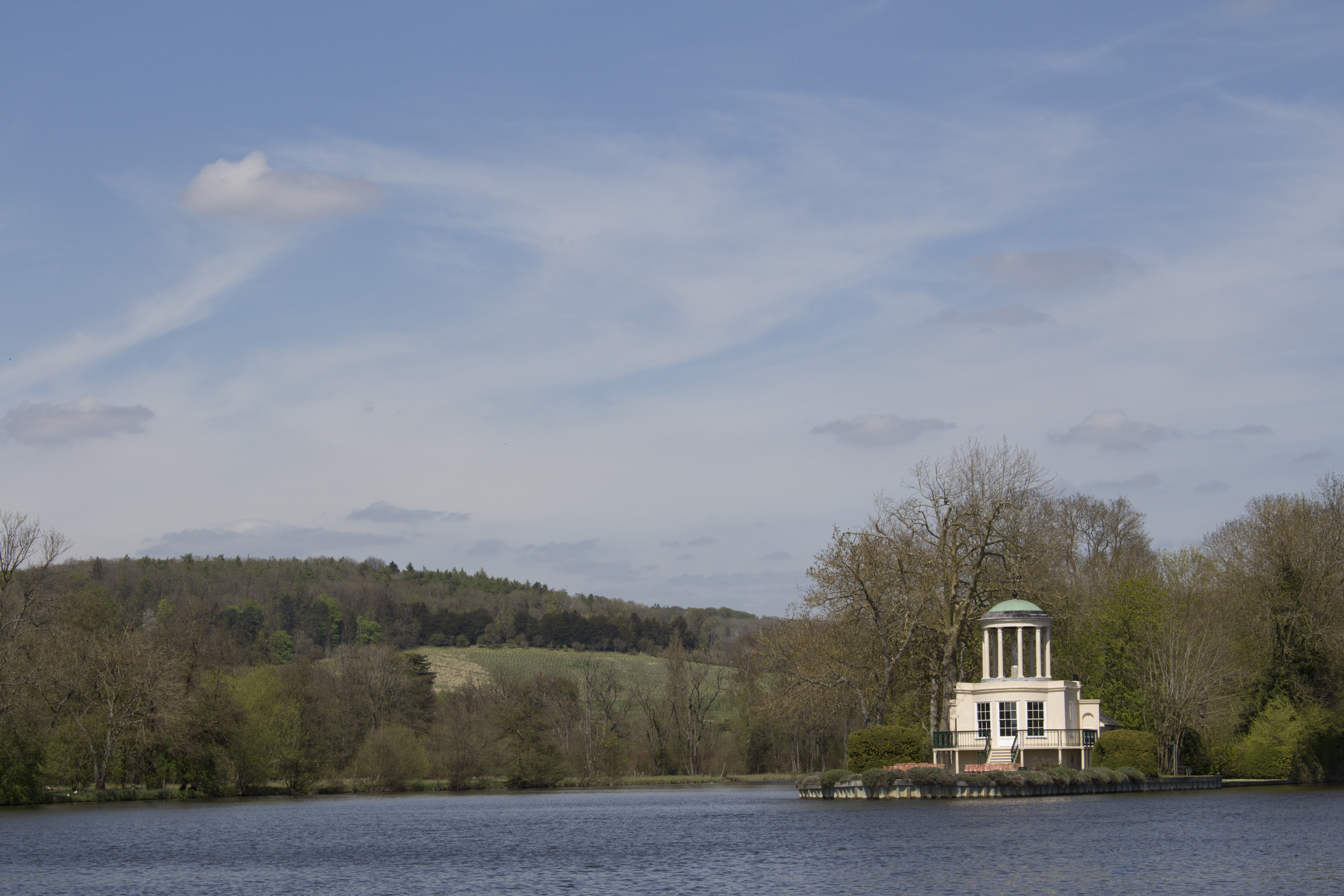
Click here to see the full resolution image
The camera has got the colour and exposure just right here and there’s lots of detail visible, so the end result has plenty of impact.
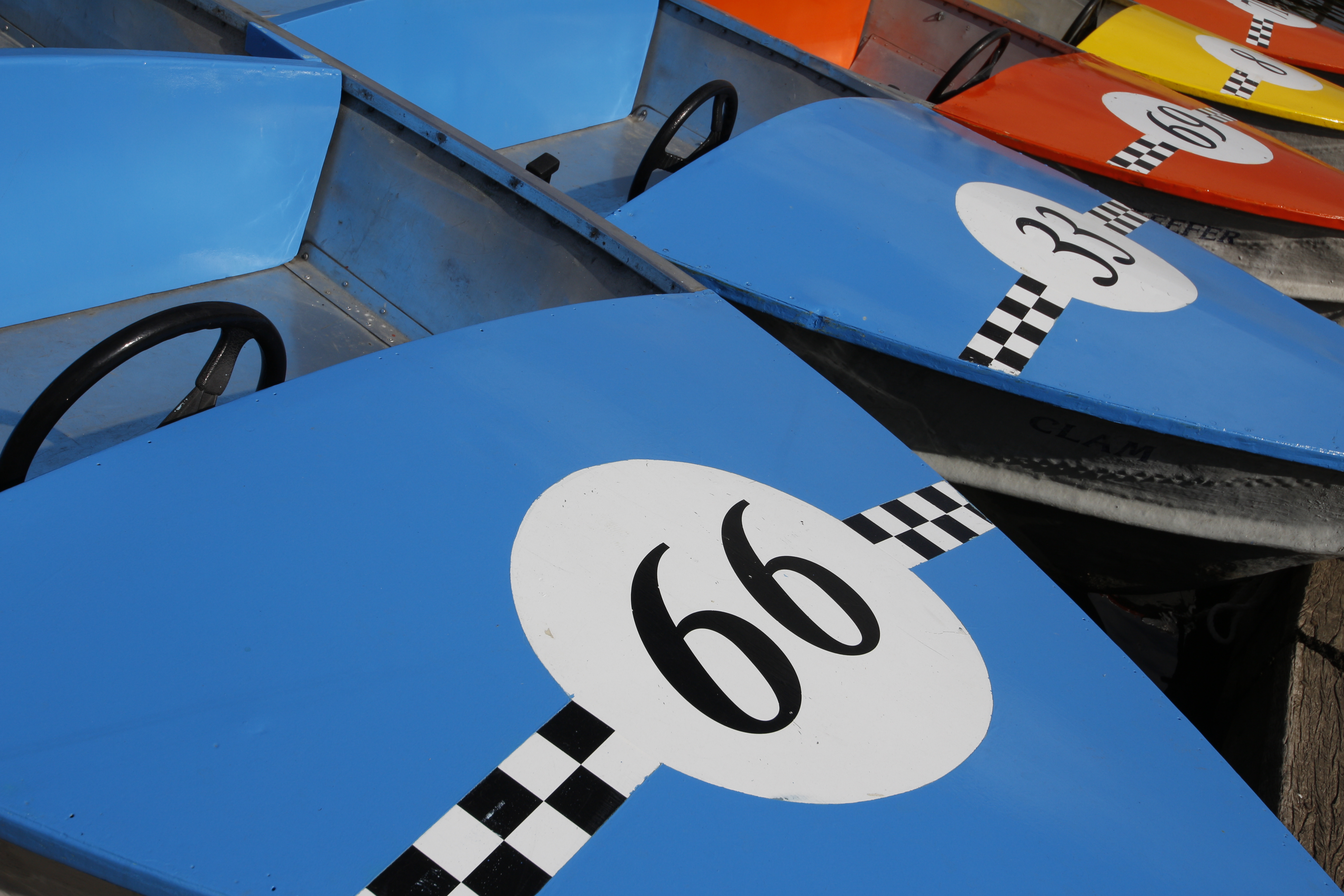
Click here to see the full resolution image
Colours are nice and vibrant but not excessively saturated when the Standard Picture Style is used.
JPEG
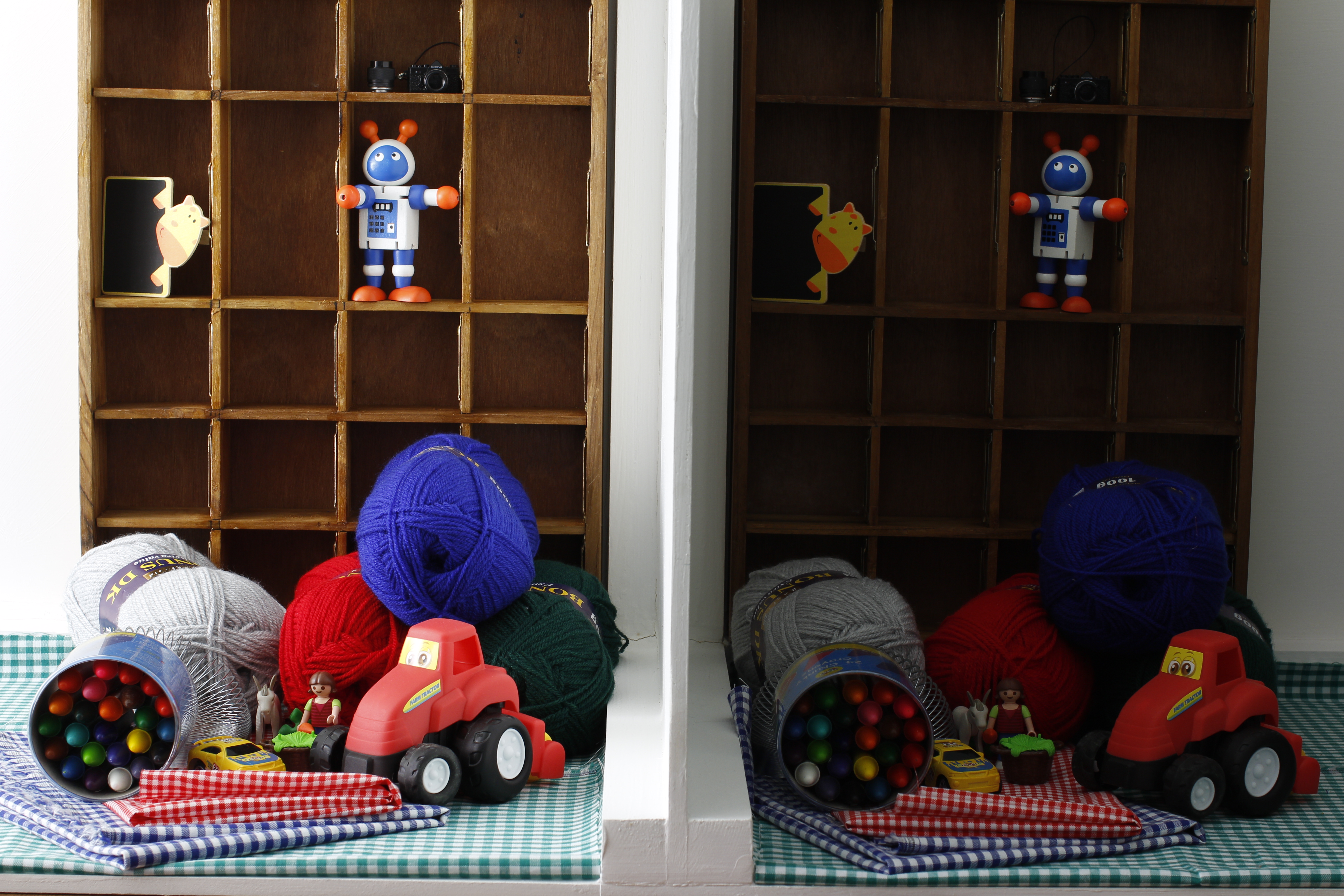
Full ISO 100 image, see the cropped (100%) versions below.

ISO 100 (Click here to see the full resolution image)

ISO 200 (Click here to see the full resolution image)

ISO 400 (Click here to see the full resolution image)

ISO 800 (Click here to see the full resolution image)
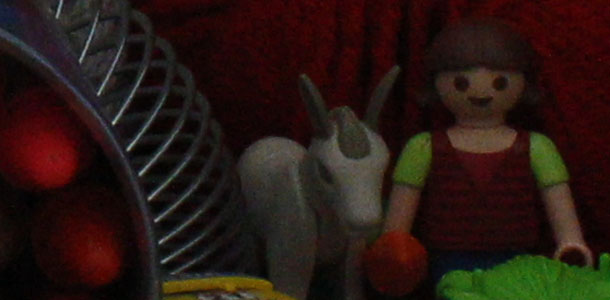
ISO 1600 (Click here to see the full resolution image)

ISO 3200 (Click here to see the full resolution image)

ISO 6400 (Click here to see the full resolution image)

ISO 12800 (Click here to see the full resolution image)
Raw
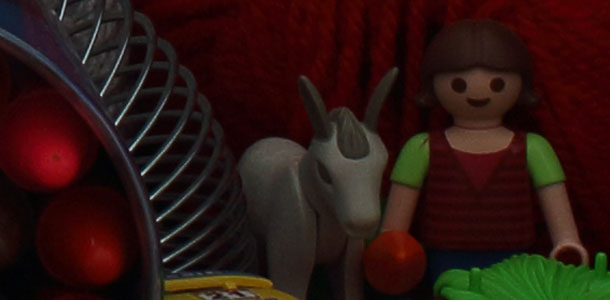
ISO 100 (Click here to see the full resolution image)

ISO 200 (Click here to see the full resolution image)

ISO 400 (Click here to see the full resolution image)

ISO 800 (Click here to see the full resolution image)

ISO 1600 (Click here to see the full resolution image)
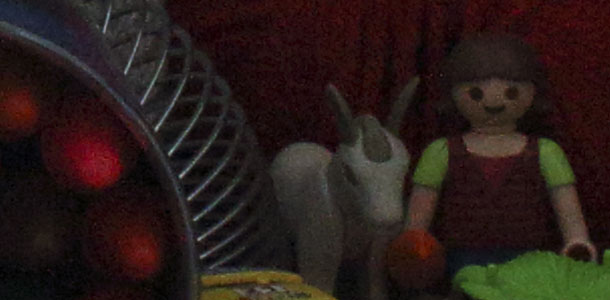
ISO 3200 (Click here to see the full resolution image)

ISO 6400 (Click here to see the full resolution image)

ISO 12800 (Click here to see the full resolution image)
The Canon EOS 700D is a superb camera that combines some of the best aspects of modern digital camera technology. It has a good sensor capable of recording lots of detail, a comprehensive feature set and a responsive vari-angle touchscreen that provides a quicker method of controlling the camera than buttons and dials – for those who want to use it.
It is an excellent choice of camera for anyone wanting to take their photography more seriously, shoot from creative angles or start recording videos. However, it is only a minor improvement on the Canon EOS 650D, and owners of this slightly older camera need feel no compulsion to upgrade.
That said, the hybrid focus system is significantly better; it’s more sensitive and quicker to respond when the shutter release is depressed. It still isn’t fast enough for use with moving subjects, though.
However, when Movie Servo AF is enabled and an STM lens is mounted, the Canon 700D brings subjects smoothly and silently into focus to produce high-quality video footage, with no hunting in good light.
When shooting with the camera held to the eye, the Canon 700D reverts to the more standard phase detection AF system, which is fast, efficient and useful when shooting a range a range of subjects, including sport and action.
We liked
Because the Canon 700D has the full complement of button and dial controls as well as the touchscreen, photographers can choose how they wish to use it.
The vari-angle screen comes into its own when shooting landscape, macro or still life images, and you have time to consider the composition and ensure the point of focus is exactly where you want it. It’s also extremely helpful when shooting video clips.
We disliked
The main source of complaint about the Canon EOS 700D is that it’s only a very minor upgrade on the Canon EOS 650D, and that it uses the familiar 18MP APS-C format sensor. While this may seem like a strange move for Canon, why should a company wait to make improvements to an existing model?
One downside to controlling the camera via the touchscreen is that the LCD is quickly covered in fingerprints and greasy smears, which make the images hard to see in bright light.
It’s a shame that Canon hasn’t made the ratings option easier to access when reviewing images, nor included Wi-Fi technology to enable wireless control over the camera for wildlife photography, as well as cable-free image transfer.
Nikon stuck with its 12MP sensors for a long time, but it has now progressed onto 24MP sensors, which have been widely well received. Canon seems to be stuck at 18MP for its APS-C format DSLRs, and although the image quality is very good, some may argue that it is a little behind the times.
Our lab tests also reveal that the Canon 700D lags behind the Nikon D5200 and Sony Alpha 58 for dynamic range and signal to noise ratio.
Final verdict
The Canon EOS 700D is a very capable and versatile camera that produces high quality images. It has a comprehensive feature set and affords all the control expected by enthusiast photographers while providing automatic hand-holding options for less experienced users.
It produces images that are of very similar quality to those from the Canon 650D, although our tests reveal that they are a little noisier.
The 700D once again highlights the benefits of shooting raw images rather than JPEGs as being able to tailor the noise reduction and sharpening to the specific conditions produces higher quality results.
While some may scoff at the vari-angle touchscreen, we say don’t knock it until you’ve tried it. It’s extremely responsive and it promotes creativity. We are becoming increasingly used to touchscreen control on a range of other devices, so it seems odd that Nikon hasn’t yet employed the technology in a DSLR.